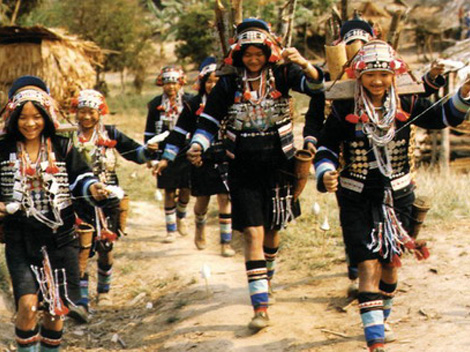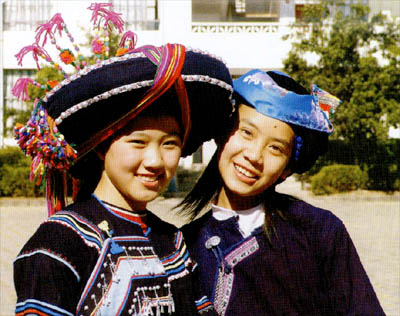
Like all other Hani people, Biyue people also prefer black, the noblest color to them. So their costumes, from cap (turban) to jacket, trousers and even shoes, are mainly black and navy. As for style and decoration, one would be surprised at the elaborately embroidered pattern on the outermost long loose dress of a Biyue woman when it is spread out. The pattern not only embodies beauty, but also records the thousand-year history of the Hani ethnic group warring and moving from the northwest to the south.
On the upper part of the dress are dots with red circles and black cores, signifying that Hani people used to leave their beloved home and start the migration journey at a starry night; the red silk thread lines tell that people died at every place the Hani ethnic group used to settle in and were buried there. Red stands for blood, and the randomly curving lines stand for the sorrow of the living and the unknown future.
It is said that the countless black, red, blue and white silk threads hanging below the hemline are tears. Hani people settled down in one place after years of toilsome efforts of every clansman, young or old. However, they had to tear themselves away from their homestead and keep moving to another place as a result of war or natural disaster.

In the middle of the dress, there are two flexural and equidistant crossed lines, red,white and black, which stand for the migration route of the Hani ethnic group. The red line indicates that the journey Hani people went through was full of tough battles in which they paid with blood. The black line here means that despite the tremendous cost, there were happy times in the thousand-year migration.
The story goes that Hani people used to wear white clothes at the very beginning. Then, as a result of war or something, they gradually formed the habit of wearing black. The white color here stands for the peaceful life in the earliest time and that Hani people will never give up their pursuit for a happy and peaceful life.
On the embroidered pattern of the Biyue people of Hani ethnic group, there are a lot of white lines and blanks. Then, what do the three flexural lines stand for? The three lines indicate that the roads Biyue people had taken were tortuous and dismal. Some old Hani men said, of the three lines, the black one represents the headman that led Hani people to fight and build their homestead; the red one stands for Beima, the inheritor and disseminator of all Hani cultures; and the white line represents craftsmen that were producers of all laboring tools and weapons, directors of house building projects, and representatives in building their homestead as well. The grass-like patterns are ferns, indicating that Hani people lived in a relatively humid environment half-way up the mountains. The palm-size sleeves are embroidered with the Honghe River running up and down from the left to the right with appropriate bend, and connecting upper and lower patterns. This is why surging rivers can be found in all embroidered costumes of Hani ethinc group. Besides the obvious pattern of the Honghe River, there are diamond patterns on the upper part of the sleeves in a picturesque disorder, standing for the terrace Hani people have reclaimed for hundreds of years.
